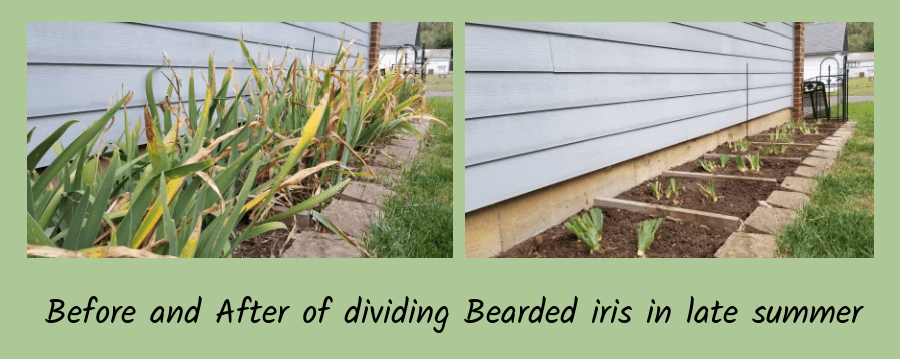Gardening chores for late summer include division, cutback, deadheading, fertilizing, and harvesting. We do not typically think of August as a time to be working in the garden. It is hot outside right? Now is the time when we gardeners want to be lazy or go on summer vacations before school starts again for our kids. If you are like my family though, you would homeschool your kids and take vacations when you want to.
Over the past few years, August has been the start of the rainy season for Northeast Kansas gardeners. We have enjoyed the cooler weather too, despite historical heat waves in August. Now is the time to do some much needed garden chores.
Gardening Chores 1 : Dividing Perennials
Several of our favorite perennials can be divided now, since they have finished their bloom period and are getting ready to store energy for overwintering. From August to the first frost in October, it is a good time to divide daylilies, hosta, peonies, ornamental onion, and iris. This can be done if plants are getting too big, if you want to share with your friends, or simply to start a new bed.
Before you begin to divide, it is important to know where you are placing the divisions. Have a spot picked out or a new landscape bed ready. Or have your gardening friends on call!
How to Divide Daylilies
Daylilies have small, tuber-like storage roots that grow off a fan of leaves. When dividing them get a fan of leaves with roots as one division. This can be done by digging the whole plant up and separating each fan out. Or you can usually dig out individual fans with a soil knife or spade.
Replant the individual fans at least 12 inches apart from each other or other plants. You can cut the top of the fans down to 4 inches of foliage to make it easier.
How to Divide Hostas
Hostas are best divided and replanted in the fall. They grow in clumps with stringy roots. Some hostas are considered groundcover types and spread naturally over a large area. All hostas get wider every year they are in the ground.
Dig up the hosta plant with a spade or shovel and wash the soil off the roots. Then gently ease the individual clumps apart until you have separate plants. Replant in shady spots.
Pair your hostas with coral bells, ferns, toad lily, columbine, and epimedium. Or check our native spring ephemerals to add to the shade garden.
How to Divide Peonies
Peonies are one of the longest-lived perennials in our gardens. Most of us have peonies for sentimental reasons-because our grandmother’s had them. They benefit from division about every 10 years. Since it takes peonies about 3 years to get back to bloom potential after division, the longer you can go between divisions, the better.
Peonies have thickened storage-type roots. Almost any amount of roots will produce new plants, so if you want to move the entire plant, get all the roots!
Dig up the plant with a spade or shovel and then wash the soil off the roots. Individual plants with roots are easy to break apart. replant into new holes, at least 3 feet apart for maximum growth. Plant in full sun.
How to Divide Ornamental Onion
Alliums became one of my favorite perennials when ‘Millenium‘ came out a few years ago. This is one of the easiest perennials to grow for a border and very easy to transplant around the yard. In the fall o 2019 I dug up a massing of 19 clumps and divided it into over 150 plants!
Ornamental onions grow as clumps of bulbs with root hairs under the bulbs. When dividing, dig up a clump, wash off the soil and gently pull apart bulbs with your fingers. 1 or 2 bulbs can be replanted into new spots. I like to use them for borders, but they are also great in drifts or masses.

How to Divide Iris
There are 2 types of iris that I am concerned with when dividing: bearded and Siberian. Bearded iris are the showy, old-fashioned iris that everyone has growing in large colonies. They have thick rhizomes with stringy roots. They are very fragrant and come in a wide range of colors.
Bearded iris should be lifted from the soil with a potato fork or gently with a shovel. Try not to break too many rhizomes when digging. Wash the soil off the roots and cut apart individual plant rhizomes with sharp knife or break by hand. When replanting, the rhizome should sit on top of the soil and stringy roots go underground.
Siberian iris has smaller rhizomes and grows into large clumps, instead of colonies. The easiest way to divide large clumps is to dig the whole thing out with a shovel, then chop the clump into sections with the shovel. Replant individual sections. Plant Siberian irises in full to part sun, and pair them with daylilies, butterfly milkweed, and coreopsis.

Gardening Chores 2 : Cutting Back Perennials
In midsummer, many off our perennials need to be cut back to encourage continued blooming and to freshen them up for the fall. Catmint, salvia, daylilies, and veronica all benefit from a haircut at this time.
Cutting Catmint
Catmint, especially varieties like ‘Walker’s Low’ and ‘Purrsian Blue’ can be cut back by at least 50% at this time. They will look small and scraggly for a few weeks and then they will erupt with new growth and blooms. I like to use my pruners for cutting off the old stems, but you can also use a sharp soil knife or hedge shears.
Cutting Salvia
Salvia ‘May Night‘ is a very popular cultivar, but it really needs to be cut back in midsummer. It will continually bloom without cutting, but the older blooms will choke the newer, making it look messy. Cut back the whole plant down to the lowest set of good leaves to encourage new growth.

Cutting Daylilies
Like I mentioned above, daylilies should be cut back now to freshen up the leaves and look of the landscape. For a week or 2 after cutting, they look sparse, but they quickly regrow and often rebloom.
Smaller daylilies like ‘Stella D’Oro’ can be pulled off instead of cutting. Larger leaved daylilies are easier cut with a sharp soil knife. I like to cut them back to 4 to 6 inches tall. The cut foliage can be removed to compost pile.

Cutting Veronica
Veronica can be sheared back similar to salvia. Cut the spent flower blooms down to the lowest set of good leaves.
Gardening Chores 3 : Deadheading
If you have not already take the time to remove spent flowers stems, this is a good time to do so. I usually take some time to remove old flower stems from daylilies, hostas, and baptisia at this time. By doing this garden chore, you will make the plants look less scraggly going into fall, and will benefit from the lack of thick stems come fall cleanups.
Using sharp pruners, cut the old flower stems below the leaves and discard into the compost pile. Some flowers, such as newer roses, coreopsis, and petunias are self-cleaning, meaning that they drop off their spent flowers as they set and open new ones.
Gardening Chores 4 : Fertilization
While August is not the best time to fertilize lawns, trees, and perennials, there are several plants which benefit from a boost of fertilizer at this time. Strawberries, for those of you with them, should be fertilized now with a nitrogen rich fertilizer, such as a 10-10-10 organic. Apply 1/2 lb. per 20 feet row of strawberries.
Now is also a good time to apply a last dose of acid fertilizer to acid loving shrubs. These include hydrangeas, hollies, azaleas, rhododendrons, sweetspire, fothergilla, and boxwoods. Apply 1/2 cup of Fertilome Azalea/Evergreen Food plus Systemic per plant.
Gardening Chores 5 : Harvesting
If you are like me, then you not only have a large amount of flowers and woody plants, but you also have a large vegeatble garden. Right now, tomatoes, peppers, cucumbers, and summer squash are ripening daily. You need to pick those items as soon as possible (daily) and get them canned, freeze-dried, dehydrated, frozen, or eaten as they become available, or you rick losing the crop you strived for.
My wife and I grow a large garden and harvest continuously, to stock our pantry for the upcoming winter months, when we cannot grow enough food in a greenhouse to keep things going. And homegrown food is worth far more in flavor and nutrients that anything from the grocery store.
One of my favorite places to go for canning help is Living Traditions Homestead on YouTube.

Conclusion
Finally, you have the garden looking ready for a rebirth and you can relax until the next round of weeds grow. Grab a book and head for the hammock!




